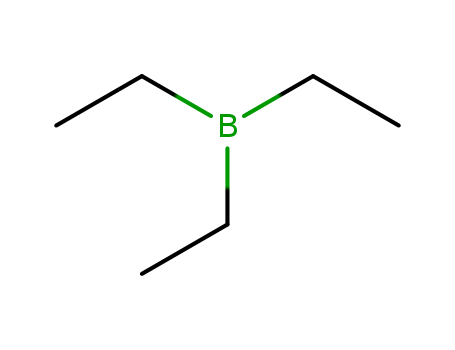10.1016/S0040-4039(01)01340-5
The research focuses on the stereoselective synthesis of the azabicyclic core structure found in batzelladine A and D, which are biologically important polyguanidinium alkaloids with potential anti-HIV properties. The researchers utilized free radical cyclization to achieve this synthesis, starting from alkyl bromide 13. Key reactants included 5-(hydroxymethyl)uracil derivatives, tris(trimethylsilyl)silane, and triethylborane, along with air, to produce azacycles with high diastereoselectivity. The study also involved the preparation of prerequisite alkyl bromides and acyl selenides, and the cyclization reactions were analyzed using techniques such as NMR and HPLC to determine the ratios of diastereoisomers and to confirm the stereochemistry of the synthesized compounds. The successful synthesis of the azabicyclic core and the understanding of its diastereoselective formation could have significant implications for the development of new therapeutic agents targeting HIV.
10.1021/ol802616u
The research focuses on the study of axially chiral carbamates as valuable substrates for stereocontrolled reactions. The purpose of the research was to investigate the chirality transfer from the N-Ar axis to a new stereocenter in substituted dihydroindole products through radical and anionic cyclizations. The study concluded that these carbamates, which include Boc, Alloc, and Cbz derivatives of N-2,4-dimethyl-6-iodophenyl-N-allyl anilines, can be resolved into atropisomers with high racemization barriers exceeding 30 kcal/mol, and they exhibit high levels of chirality transfer in both radical and anionic cyclizations. The chemicals used in the process include tributyltin hydride (Bu3SnH), triethylborane (Et3B), benzene (C6H6), n-butyllithium (n-BuLi), trimethylsilyl chloride (TMSCl), and solvents such as THF, ether, and hexane. The findings suggest that axially chiral carbamates are promising precursors for various types of transformations due to their high rotation barriers, high chirality transfer, and the ease of removal of the N-substituent.
10.1016/0022-328X(86)80470-3
The research focuses on the organoboration of alkynylboranes, specifically diethylamino-bis(trimethylstannyl-ethynyl)borane. The purpose of this study was to synthesize new boron-containing compounds, namely 1-diethylamino-2,5-bis(trimethylstannyl)-3-diethylboryl-4-ethylborol and 1-diethylamino-2-diethylboryl-3,5-bis(trimethylstannyl)-4-ethylborol, through a stepwise reaction process monitored by NMR spectroscopy. The results were compared with those obtained from the organoboration of bis(diethylamino)-trimethylstannylethynylborane. Key chemicals used in the process included diethylamino-diethinylboran, trimethylstannyl-derivatives, triethylboran, and trimethylboran. The study concluded that the organoboration reactions proceeded with the formation of new heterocycles and that the NMR spectroscopy data provided valuable insights into the reaction progress, isomer formation, and the structural assignments of the synthesized compounds. The final product, borol 13, remained as the only reaction product after 7 days at 60°C in benzene, indicating its stability under the given conditions.
10.1021/jo952235c
The research describes a method for the hydroxyl-directed reductive cleavage of 3-oxetanols to synthesize diastereomerically pure 1,2-diols, which is of significant interest in organic synthesis due to the challenge of reversing the polarity of a carbonyl compound from an a1 to a d1 synthon. The researchers utilized a photocycloaddition of silyl enol ethers to aromatic aldehydes, resulting in the formation of oxetanes, which were then subjected to a selective SN2-type ring opening. The key reagents in this process included lithium tris(tert-butoxy)aluminum hydride (LTBA), triethylborane (BEt3), and tetrahydropyran (THP), as well as potassium carbonate (K2CO3) and lithium aluminum hydride (LiAlH4). The study concluded that the methodology offers a more stereoselective approach to 1,2-diols bearing a secondary and a tertiary center compared to conventional methods, with the overall yield of diastereomerically pure diol ranging between 36 and 59% for the three-step procedure. The researchers are further investigating the scope of these hydroxyl-directed ring-opening reactions.
10.1039/b101074n
The research focuses on the development of solid-phase tandem radical addition-cyclisation reactions of oxime ethers connected with α,β-unsaturated carbonyl groups. The purpose of this study was to effectively form azacycles or chiral oxacycles through C-C bond-forming reactions on a solid support under mild conditions. The researchers used triethylborane as a radical initiator, which demonstrated potential for inducing intermolecular and intramolecular radical reactions on solid support. Key chemicals involved in the process included oxime ethers, a,β-unsaturated carbonyl groups, iodine atom-transfer reagents, and various radical precursors such as cyclohexyl, cyclopentyl, and sec-butyl iodides.



 F+,
F+, C,
C, N,
N, F
F


